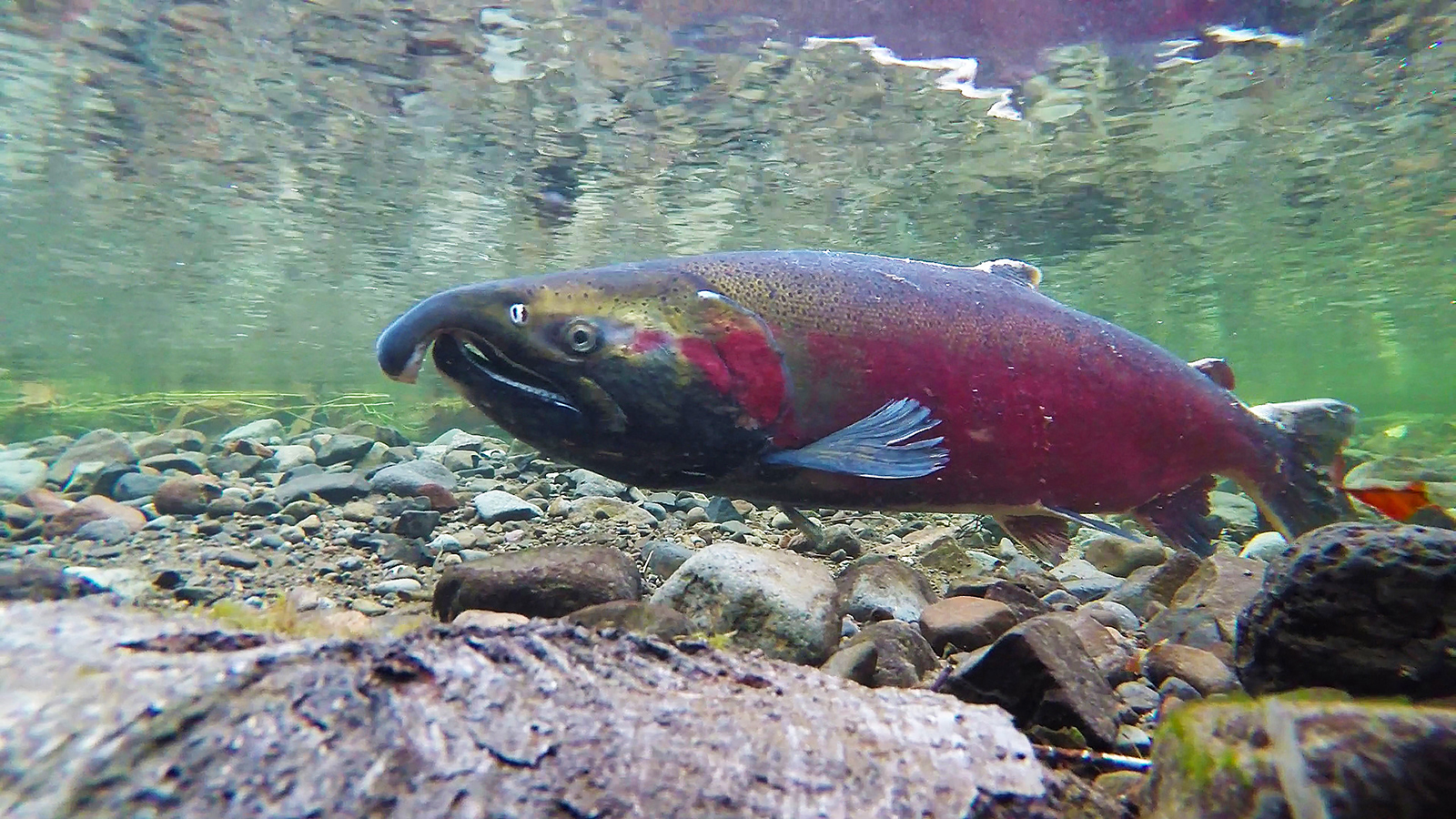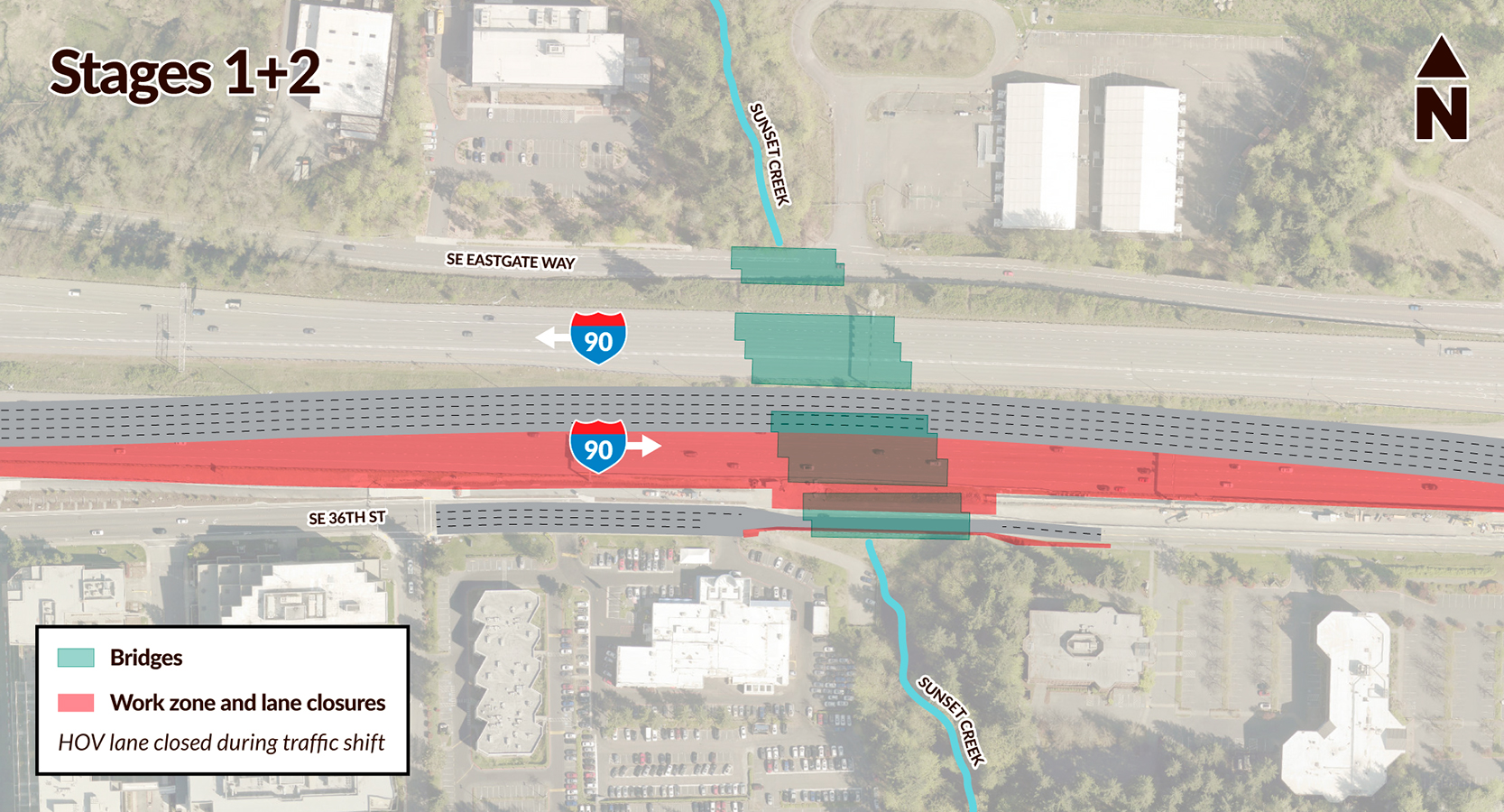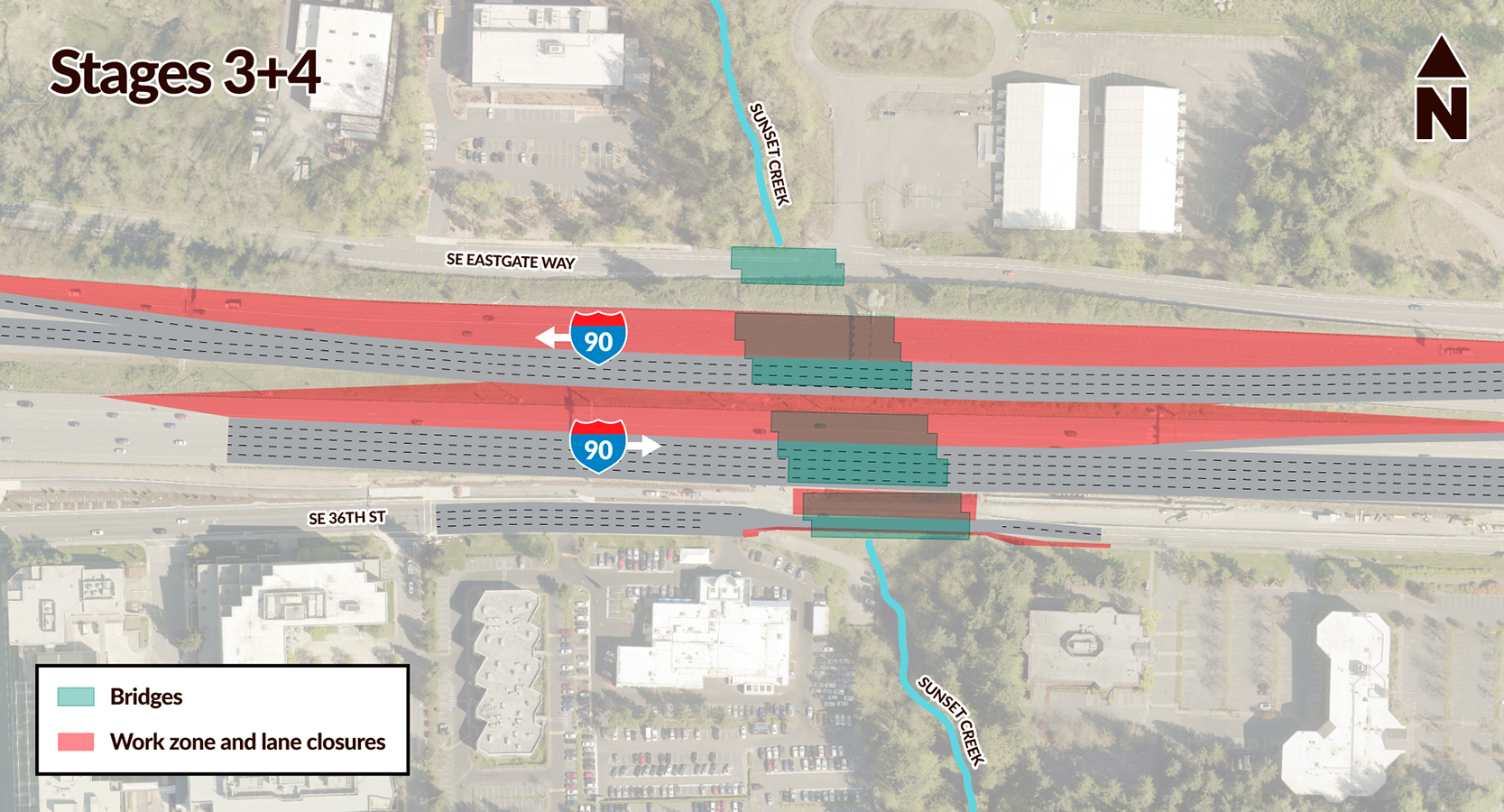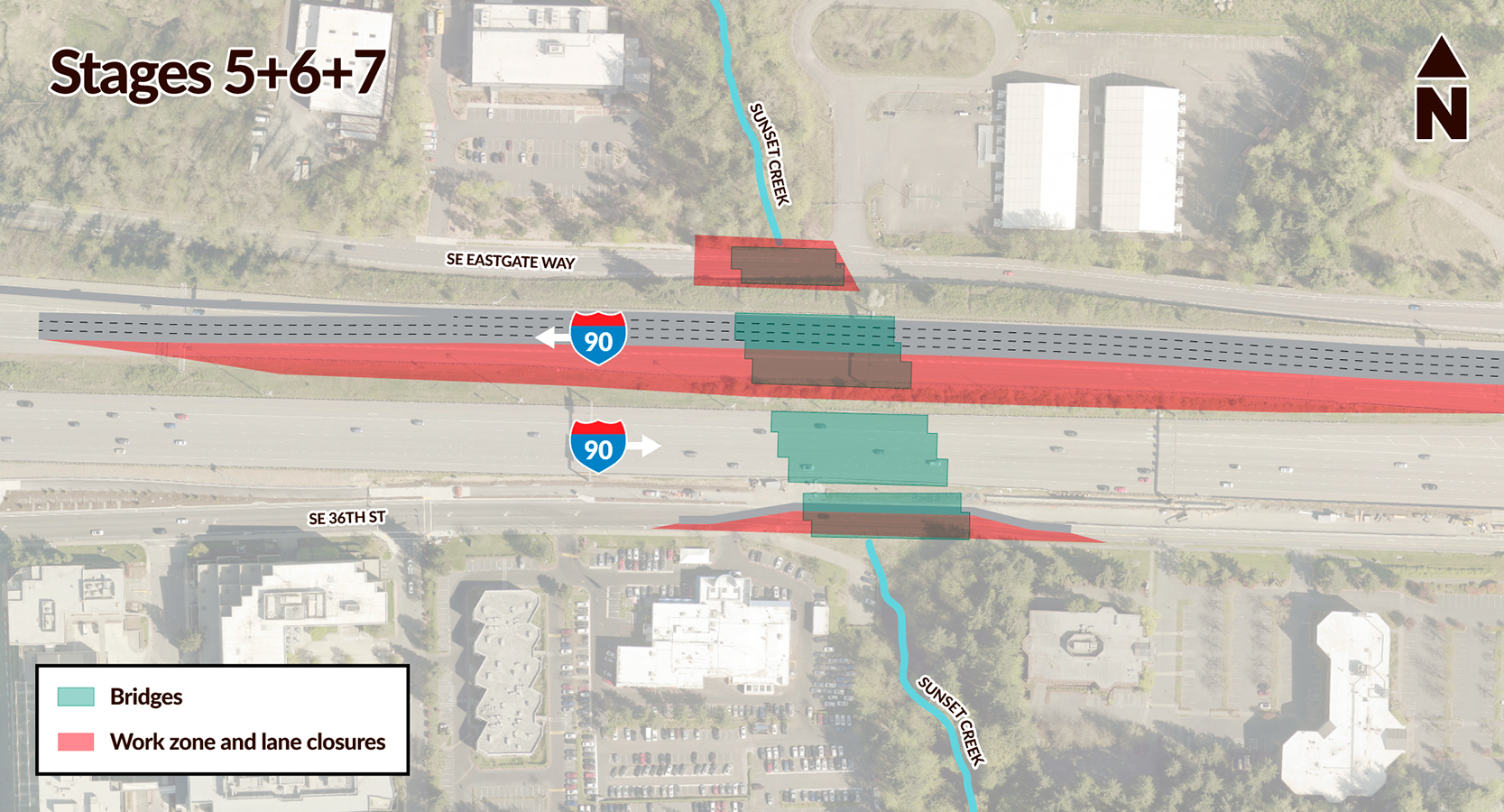I-90 West Fish Passage – Sunset Creek
On this page: Background | Schedule | Project benefits | Tribal coordination | Construction
Background
The Washington State Department of Transportation is restoring and improving access for native fish species to streams and rivers by removing culverts and other barriers to fish passage. In western Washington, that means building hundreds of bridges and other structures under state highways to help fish access upstream habitat where they can breed and grow.
To achieve this, we will build four bridges – two under Interstate 90 and two under local roads in Bellevue, which will restore the natural stream conditions of Sunset Creek. Building these bridges and removing culverts will open up access to 1.65 miles (2.65 km) of habitat for native salmon and steelhead.
 We will build four new bridges under I-90, Southeast Eastgate Way and Southeast 36th Street.
We will build four new bridges under I-90, Southeast Eastgate Way and Southeast 36th Street. One of the culverts blocking fish migration beneath I-90 at Sunset Creek. The culvert is too high for fish to access, so it will be removed once we complete building the bridges.
One of the culverts blocking fish migration beneath I-90 at Sunset Creek. The culvert is too high for fish to access, so it will be removed once we complete building the bridges.Schedule
This project is combined into a single contract with two other King County fish passage projects on SR 161 in Federal Way and SR 202 and 203 in east King County. Construction for this combined project will start in 2023 and continue through 2026, beginning with I-90 Sunset Creek. More information about this project, including upcoming traffic closures can be found on the I-90 Sunset Creek project page.
Project benefits
This project is part of WSDOT’s fish passage recovery program that reconnects streams and rivers across Washington. Improving fish passage for salmon and steelhead provides environmental, cultural, and economic benefits, including:
- Providing an important food source for over 100 species of wildlife, including orca.
- Upholding cultural connections for tribes whose traditions and lifestyles have relied on salmon and steelhead for millennia. Washington state must uphold treaty-reserved fishing rights, ensuring that salmon are present and available for harvest.
- Supporting an estimated 16,000 jobs and over $500 million in income through recreational and commercial fishing and habitat restoration work.

When rivers and streams are reconnected, fish can better access the habitat they need to forage, reproduce, and find refuge from predators and high winter stream flows.
Tribal coordination
Fish barriers along roads and highways prevent Tribes in western Washington from exercising their treaty-based fishing rights. While progress has been made since 1991, a 2013 federal court injunction requires WSDOT to open 90% of habitat blocked by state culverts by 2030. In the design phase of this project, WSDOT worked closely with the Muckleshoot Indian Tribe to select features that will help revitalize Sunset Creek, opening up access to its vital habitat for native fish species.
Construction
Constructing Fish Passable Structures Under I-90 and Local Roads
Contractor crews working for the Washington State Department of Transportation will build four new bridges, digging down nearly 100 feet under the existing roadway to remove existing culverts. Construction will require lane shifts on I-90 and road closures on Southeast Eastgate Way and Southeast 36th Street. Once complete, this project will create a natural stream bed to flow under I-90 and open access to nearly two miles of restored habitat for salmon and steelhead.
Construction along I-90 starts in 2023 and will continue through 2026. People traveling and living in the area can expect:
- Long-term lane reductions and lane shifts for both directions of I-90
- A single lane of alternating traffic on Southeast 36th Street for up to 1.5 years
- A six-month full closure of Southeast Eastgate Way
- Temporary shift of the Mountain to Sound Trail and Sunset Ravine Trail
- Stream restoration, adding native plants, logs and boulders to support fish habitat
Shifting Traffic in Stages
Construction crews will shift traffic in stages to build four new bridges – two under I-90, one under Southeast Eastgate Way and one under Southeast 36th Street. Each traffic shift will last for several months while crews excavate and replace culverts. Up to five lanes of traffic will always be maintained, and bike and pedestrian trails will be detoured. Major traffic stages are illustrated below.
Spring 2023 - Summer 2023

- As early as May 15, crews will close the eastbound I-90 HOV lane to shift traffic around the construction zone.
- Crews will widen the Southeast 36th Street sidewalks for a Mountain to Sound Greenway Trail detour.
- In summer, crews will shift I-90 eastbound traffic into a new configuration while the southern portion of the I-90 fish passage bridge structure is built.
- Lanes will be reduced on Southeast 36th Street to a single one-way road with signalized, alternating traffic.
Fall 2023 – Spring 2024

- Eastbound I-90 traffic will shift to the right lanes of the new eastbound bridge to allow crews to construct the remaining north portion of the bridge.
- Once the eastbound bridge structures are complete, crews will shift traffic on westbound I-90 to build the north portion of the I-90 bridge and Mountain to Sound Greenway Trail.
Spring 2024 – Fall 2026

- Crews will shift traffic to the final configuration on eastbound I-90 and on Southeast 36th Street.
- Crews will shift westbound I-90 traffic to build the build the remaining south portion of the fish passable bridge structure on I-90.
- Crews will close South Eastgate Way Bridge for up to 6 months to complete construction on the Southeast Eastgate Way Bridge.
- Major construction will be complete by fall 2026.





